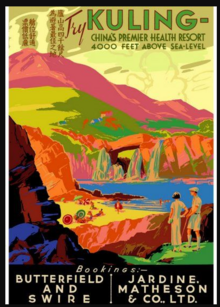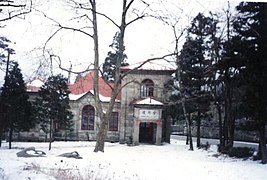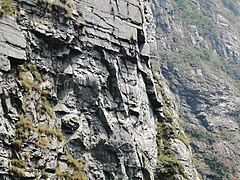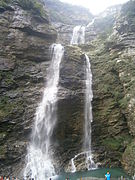Mount Lu
This article needs additional citations for verification. (February 2020) |
| UNESCO World Heritage Site | |
|---|---|
 | |
| Official name | Mountain Lu National Park |
| Location | People's Republic of China |
| Criteria | Cultural: (ii), (iii), (iv), (vi) |
| Reference | 778 |
| Inscription | 1996 (20th Session) |
| Area | 282 square kilometers (109 sq mi) |
| Coordinates | 29°26′N 115°52′E / 29.433°N 115.867°ECoordinates: 29°26′N 115°52′E / 29.433°N 115.867°E |
 Location of Mount Lu in China | |


Mount Lu or Lushan (simplified Chinese: 庐山; traditional Chinese: 廬山; pinyin: Lúshān, Gan: Lu-san), offically named Mountain Lu National Park, is a mountain in China. It was also known as Kuanglu (匡廬) in ancient times. It is situated in Jiujiang in Central China, and is one of the most renowned mountains in the country. Mount Lu is located primarily in Lushan county-level city in Jiujiang Prefecture, although the northern portions are found in Lianxi District which was formerly known as Lushan District and until 2016 covered the majority of the Mount Lu. The oval-shaped mountains are about 25 kilometers (16 mi) long and 10 kilometers (6.2 mi) wide, and neighbors Jiujiang city and the Yangtze River to the north, Nanchang city to the south, and Poyang Lake to the east. Its highest point is Dahanyang Peak (大汉阳峰), reaching 1,474 meters (4,836 ft) above sea level, and is one of the hundreds of steep peaks that towers above a sea of clouds that encompass the mountains for almost 200 days out of the year. Mount Lu is known for its grandeur, steepness, and beauty and a prominent tourist attraction, especially during the summer months when the weather is cooler in the mountains than elsewhere. The mountain and the surrounding region is one of the "spiritual centers" of China, containing many Buddhist and Taoist temples in addition to landmarks of Confucianism.[1] Because of its striking beauty and sacred importance, Lushan National Park has been a UNESCO World Heritage Site since 1996.[1] The overlapping Lushan Quaternary Glaciation National Geopark is a member of UNESCO Global Geoparks Network.
History[]
Lushan contains important sites and temples for Taoism, Buddhism, and Confucianism. Between 386 and 402 AD in the Jin Dynasty, Huiyuan founded Pure Land Buddhism and Donglin Temple on the slopes of Lushan.[1] During the Tang Dynasty (618-907), Taoist temples were constructed nearby to house sacred scriptures.[1] The White Deer Grotto Academy, founded in 940 AD, developed into a renowned center of academic research during the Song Dynasty under the direction of Confucian scholar Zhu Xi.[1] The academy was continually open until at least the 19th century. Other important medieval structures on the mountain include the grave of the famous Tang Dynasty poet Tao Yuanming and imperial pavilions during the Ming Dynasty.
In later years, Lushan was a summer resort for Western missionaries in China. Absalom Sydenstricker, the father of Pearl Buck, was one of the first five missionaries to acquire property in the Kuling Estate on the mountain. The development of Kuling was instigated by the Reverend Edward Little and Dr. Edgerton H. Hart.[2] The four principal founders of the China's Nurses Association and its first president, Caroline Maddock Hart; met in Kuling to form this association.[3]
During the Long March, in early 1935, a battle took place in this area between communist and republican forces, in which Hu Yaobang, later General Secretary of the Communist Party of China, was seriously injured.
Mount Lu was once dubbed the xiadu ("summer capital") of the Republic of China. Chiang Kai-shek, China's leader at the time, would frequently spend his summers here. In June 1937, Zhou Enlai, then a major leader in the Communist Party, met with Chiang on the mountain to discuss a united front against the Japanese invasion. In July 1937, Chiang Kai-shek announced his intention for a full mobilization for war against Japan from Mount Lu. In 1946, following the war, the U.S. special diplomatic mission led by General George C. Marshall met with Chiang Kai-Shek to discuss the role of post-World War II China.
Mao Zedong convened three large conferences of senior party officials at Mount Lu, in 1959, 1961, and 1970. The 1959 conference became known as the Lushan Conference. The meeting saw the purge of decorated Chinese Civil War and Korean War general Peng Dehuai, who was critical of Mao's Great Leap Forward policies. The 1970 Lushan Conference took place during the Cultural Revolution, and marked the increasing antagonism between those loyal to Mao and those loyal to his chosen successor Lin Biao.
Attractions and features[]
Popular attractions in Mount Lu include the Immortal Caverns (仙人洞), Meilu Outhouse (美庐别墅), Five Old Man Peaks (五老峰), White Deer Cavern Academy (白鹿洞书院), Three Tiled Springs (三叠泉), Luling Lake (芦林湖), Lushan Hot Springs (庐山温泉), Botanical Gardens (植物园), the Bamboo Temple (竹山寺), Guanyin Bridge (观音桥), Peach Blossom Garden (桃花源), Catholic Church of Mount Lu (庐山天主堂),[4] and many more.
- The Lushan Botanical Gardens features tens of thousands of plant species.
- Below the Five Old Men Peak is the White Deer Grotto Academy, named after the poet Li Bo (Chinese: 李渤) (not to be confused with the famous poet Li Bai), who raised white deer there. It is one of the most famous higher learning institutions in ancient China.
- West is the Flower Path which provided inspiration to Bai Juyi, a famous poet who lived during the Tang Dynasty.
- Between the Yangtze River and Lake Poyang lie the Greater and Lesser Tianchi Lakes, the Jingxiu Valley, and Lulin Lake. On the north bank of the latter is the Lushan Museum, which features pottery and bronzes dating from various periods of ancient China, as well as calligraphy from the Tang Dynasty and paintings from the Ming and Qing dynasties.
- At the centre (between three peaks), and at an altitude of over 1 kilometer above sea level, is the town of Guling, which is linked by a mountain highway to neighboring spots in the region.
- World-famous Lushan Clouds and Mist Tea (simplified Chinese: 庐山云雾茶; traditional Chinese: 廬山云霧茶) is grown in the mountains.
Gallery[]
Mountain Immortals Cave

Old church
Lake Lulin
Donglin temple
White Deer Grotte Academy

Lofty Mount Lu by Shen Zhou, 1467
The small peaks of the mountain range can be climbed by visitors.


Lushan scenic spot outside Lushan Museum



Mountain scenery near Sandie spring in Lushan Scenic Area

Lushan snow

Waterfall at Lushan

Lushan west sea scenery
Climate[]
| showClimate data for Mount Lu (1981−2010) |
|---|
References[]
| Wikivoyage has a travel guide for Lushan. |
| Wikimedia Commons has media related to Lushan Geopark. |
- ^ Jump up to: a b c d e "Lushan National Park". UNESCO World Heritage Centre. United Nations Educational, Scientific, and Cultural Organization. Retrieved 4 Apr 2021.
- ^ "The History of Lushan & Kuling" by Stanley Crawford
- ^ "Wuhu Missionaries" by Cathleen Green and Stanley Crawford
- ^ "Mount Lu | China & Asia Cultural Travel". 2017-06-09. Retrieved 2021-08-21.
- ^ 中国地面气候标准值月值(1981-2010) (in Chinese). China Meteorological Data Service Center. Retrieved 10 October 2019.
- Mountains of Jiangxi
- National parks of China
- World Heritage Sites in China
- Landforms of Jiangxi
- Tourist attractions in Jiangxi
- AAAAA-rated tourist attractions


















